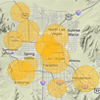Las Vegas Sun reporters Marshall Allen and Alex Richards were given two years to achieve one goal: “Find out what’s right, and wrong, about our local health care delivery system.”
The 2.9 million public documents that they examined and hundreds of interviews that they conducted exposed thousands of preventable medical mistakes in Las Vegas hospitals. The Nevada legislature responded with six pieces of legislation that are still up for debate and, this week the Pulitzer Prize Board named Allen, Richards and The Sun a finalist in local reporting.
But it is likely that the medical community would have scoffed at the stories or worse, ignored them as scare-mongering, if this innovative team had not used a wide range of multimedia tools to bring the data to life.
In an interview this week, Allen (who has since left the Sun and now works for ProPublica) said, “The biggest challenge with data is to make it meaningful to people. It can be really complicated and obscure sounding stuff if you just show charts and graphs.”
The “Do No Harm” project is based on mountains of patient billing records that hospitals are required to turn over to the State of Nevada. The Sun mapped and sorted the records, focused on preventable infections, injuries like slips and falls in hospitals, and surgical mistakes like punctures and cuts that happen during surgery.
“Alex (who now works for the Chronicle of Higher Education) did the database CAR work,” Allen said. “At least a dozen times while he was cleaning the data to make it understandable, he sent the data back to the hospitals or to the state to get them to correct mistakes. We found mistakes in their own data that they didn’t find.”
When they sent the data back to the authorities, it built credibility because hospitals and regulators started to understand The Sun was serious about getting the story right, Allen said.
The project would have been easier and faster to complete if it had been based on what Allen calls “sobbing anecdotal evidence.”
But “the hospitals would have dismissed the sob stories,” he said. “We knew this would be very controversial for the hospitals — we found a method to impose transparency on them. We had to show the data and show the documents as best we could.”
How they presented the data
The Sun team wanted to make the data local and personal to every reader.
They posted mountains of original public documents online, which allows readers to see for themselves how the journalists know what they know. By using DocumentCloud, the reporters could highlight and annotate the documents to help readers see what was important and learn a document’s back story.
Readers responded. “We know that there were tens of thousands of page views on those documents,” Allen says.
For Part 1 of the series, the team produced an interactive graphic that allows the online user to sort by different preventable injuries or by hospitals to see where people are getting hurt.
In Part 2, Richards and Allen explore “A Hidden Epidemic” — the spread of deadly infections in hospitals. Though that story has been covered before, The Sun created a map, with a timeline, that shows the spread of infections hospital by hospital.
Part 3 may be the most sobering installment of all. The Sun found that some Las Vegas hospitals have twice the expected rate of punctures and lacerations that mistakenly occur during surgery.
The story said, “The Sun analysis of 2008 and 2009 records revealed 710 accidental punctures or lacerations — more than half during elective procedures. In 38 cases, the patient died in the hospital. (Billing records do not indicate whether the injuries contributed to each patient’s death. In nonfatal cases, it’s possible injuries were identified and fixed during surgery, with little harm to the patient.)”
The Sun produced an online graphic that allows the reader to see, hospital by hospital, where surgical injuries happened more often than would be expected.
Part 4 looked at patient complaints. The Sun documented 140 substantiated complaints that people filed with the state in one year. Then the journalists sorted the complaints by type and by hospital and created a clickable repository so readers could see detailed official state documents related to the cases.
“When you do a print story — I know most people are not going to read an 80 to100 inch story with three 20-inch sidebars,” Allen said. So the team tried to create multiple ways for readers to use and understand the data.
Use of video, photos and audio
The Sun also put faces on the numbers. Sun Photojournalist Leila Navidi, video journalist Trent Ogle and Interactive producer Tyson Anderson built stunning galleries.
Each of the segments included video interviews with the people whose stories were told in the print stories.
The team built large thumbnail online galleries. Click on the faces and hear firsthand from people who have experienced the troubled Vegas health care system. The thumbnails can even be sorted by the kind of injury or illness the patient experienced (see bottom of the thumbnail page and click on “pressure sores,” “infections,” etc.)
When the stories started running, the paper’s phones rang off the hook. Rather than let the calls fall into the digital abyss, the team edited some and provide a sampling of the public’s reaction. They also posted reader reaction to the website, allowing people to share their personal experiences with Vegas-area hospitals.
Marshall Allen invited readers to share their stories using an easy online form.
Impact
The Las Vegas Sun relied on solid data-based reporting but didn’t stop there. They brought the numbers to life. They made health care providers and lawmakers take notice. These journalists — and people who supported them, financed them, edited them, designed the project — they may have saved lives.
Al Tompkins takes you on a walkthrough of the Las Vegas Sun project in the video below:








Comments